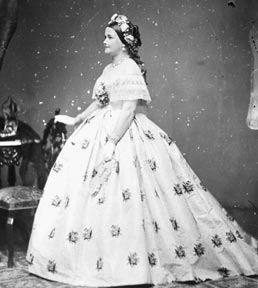WOMEN IN HISTORY - MARY TODD LINCOLN
Wife of President Abraham Lincoln, misrepresented by popular history and maligned by her peers
DATE OF BIRTH
December 13, 1818
|
PLACE OF BIRTH
Lexington, Kentucky
|
DATE OF DEATH
July 16, 1882
|
PLACE OF DEATH
Springfield, Illinois
|
FAMILY BACKGROUND
Mary Ann Todd was the fourth of seven children born to Robert Smith and Eliza Parker Todd. As a prosperous store owner and state senator, Robert was quite prominent in Lexington. Eliza died after giving birth to her seventh child, when Mary was six years old. A year and a half later, Robert married Elizabeth (Betsy) Humphreys of Frankfort, Kentucky. This marriage brought nine more children into the house. Mary’s stepmother was not sympathetic toward her stepchildren, which, some historians comment, might have contributed to Mary’s insecurities later in life. Despite growing up in the south with household slaves, Mary very early on grew to abhor slavery.
EDUCATION
Unlike most men of that era, Mary’s father felt women should be well educated. At the age of eight years, Mary began her formal education at Shelby Female Academy. At age 14, Mary entered Madame Victorie Mentelle’s select academy for young ladies, just outside Lexington. After that, she moved to Springfield, Illinois, to live with her sister Frances, who had married Dr. William S. Wallace. After three months, Mary returned to Shelby Female Academy for two more years.
ACCOMPLISHMENTS
In 1839, upon finishing her schooling, Mary returned to Springfield to live with another sister, Elizabeth, who had married Ninian W. Edwards. As the son of a former governor of Illinois, the Edwardses were socially prominent and Mary became a popular belle.
In the fall, she met Abraham Lincoln at a dance. He was 10 years her senior and an aspiring lawyer. They fell in love and were engaged at the end of the following year. Mary’s sister and brother-in-law did not approve. In January 1841, perhaps with his poorer background and debt in mind, Abraham asked Mary to release him from the engagement. After much depression, a friend arranged for them to get together again. After another year of clandestine meetings and secret preparations, on November 4, 1842, Mary informed the Edwardses that they were getting married that day. Realizing it was inevitable, the Edwardses had the wedding take place in their home that evening. Inside Mary’s ring was the inscription “Love Is Eternal.”
The Lincolns had four sons: Robert Todd (August 1, 1843), Edward Baker (March 10, 1846), William Wallace (December 21, 1850), and Thomas “Tad” (April 4, 1853). With Abraham earning a modest income, they first lived in an $8-a-week room at the Globe Tavern in Springfield. They soon moved to a small three-room cottage, then six months later, in 1844, they moved to the only home they would ever own.
With Abraham’s work keeping him away, they stayed in touch through letters, with him relying more and more on Mary’s careful analysis of books and political reports. She helped Abraham collect fees for his services and continuously promoted him, even predicting that he would become president. “He is to be President of the United States some day,” she said. “If I had not thought so, I never would have married him, for you can see he is not pretty. But look at him: Doesn’t he look as if he would make a magnificent President?”
Abraham was elected to the House of Representatives in 1846 and the family moved to Washington, D.C., living first at Brown’s Hotel, then in Mrs. Ann G. Sprigg’s boardinghouse (now the site of the Library of Congress). Before his term ended, Mary returned to Kentucky with the boys in 1848. In 1849 his term ended and, not seeking re-election, Abraham and his family returned to Springfield. Soon, the first of Mary’s tragedies occurred. In July 1849, Mary’s father died of cholera. Less than a year later, in February 1850, Eddie died of diphtheria. He was not even four years old. Afterwards, Mary could not speak his name without crying.
Abraham’s interest in politics remained strong and Mary fully encouraged this. Continuing to dream of the presidency, she convinced him to decline an appointment as governor of the Oregon Territory. In 1855, he lost an election to the U.S. Senate, but she was developing her political acumen. With the debate over slavery heating up, Mary was adamant that Abraham not be perceived as an abolitionist, for then he would be thought a radical and have no chance of election. In 1858, Abraham ran again for the U.S. Senate, but lost to Mary’s former beau, Stephen A. Douglas. Abraham said he would “sink out of view, and shall be forgotten,” but Mary did not agree.
In 1860, the Republican party (still quite new) nominated Abraham for president. Mary made sure she and her husband were portrayed favorably to the public. Her own education and training helped disperse the image of frontier people being ignorant and uncivilized boors. During the campaign, a little girl suggested that Abraham grow a beard to appear more attractive. Most likely Mary agreed.
When Abraham won the election that year, the Civil War was imminent. Before he even assumed office, seven states had seceded, with four more after his inauguration in March. Although Mary had dreamed of a proud entry into Washington, because of an assassination attempt, they had to sneak into the capitol. Her dreams were soon further crushed with harsh criticism, disappointments and more heartache.
Southerners felt Mary was a traitor, turning against her roots, while Northerners felt she was a spy, as many of her relatives sided with the Confederacy. She received criticism when she refurbished the White House (wanting to make it “an appropriate setting for the leader of a great nation”) because she went over the budget appointed by Congress. And she received criticism for holding festive events during wartime, but in doing so, Mary made the political point that the Union government would remain in Washington.
On February 20, 1862, their son Willie died of a fever. Also, during the war, all three of Mary’s half-brothers and a half-sister’s husband were killed. With grief added to the stress of the war and the criticisms, Mary became increasingly impaired both physically and emotionally. At times, she lost herself completely in frenzied outbursts.
Yet despite all the anguish, Mary did much that was laudable. She frequently visited hospitals, bringing food and flowers, reading to the soldiers, writing them letters, and once raising $1,000 for a Christmas dinner. Her closest friend, Elizabeth Keckley, a former slave, made Mary aware of the thousands of Virginia slaves who had moved to Washington but lived in harsh conditions. Mary raised money for them through the Contraband Relief Association. And although Mary might not have been the influence for Abraham’s Emancipation Proclamation, she very strongly supported it.
In 1864, Abraham won re-election. On April 9, 1865, with General Robert E. Lee surrendering to General Ulysses S. Grant, the war was officially over. Just five days later, on April 14, Abraham was shot by John Wilkes Booth in the Ford Theater, Mary’s hand in his. The president lingered until passing away at 7:22 a.m. He was buried in Springfield, next to his two sons.
Mary never recovered from this tragedy. On May 22, 1865, she left the White House, living in Chicago with her remaining sons Robert and Tad. After Robert married in September 1868, she and Tad went to Europe, returning in May 1871. Unfortunately, Tad had caught a cold on the trip back and never fully recovered from a respiratory infection. On July 15, 1871, he died. Mary had now lost her mother, father, husband, three half-brothers, and three sons. “One by one,” she said, “I have consigned to their resting place my idolized ones, and now, in this world there is nothing left for me but the deepest anguish and desolation.”
Mary’s mental health deteriorated rapidly. She had delusions, hallucinations and irrational fears of people trying to kill her or stealing from her. Her remaining son, Robert, on his way to becoming a prominent attorney, became concerned for her health and safety. On May 20, 1875, after a juried trial, Mary was declared insane and confined to Bellevue Nursing and Rest Home in Batavia, Illinois. This news shocked the nation. Mary’s supporters believed Robert had ulterior motives and worked to get her released. On September 19, 1875, she was released to live with her sister Elizabeth in the same house in Springfield where she had married Abraham. In June 1876, another court ruled that she had regained her sanity.
Three years later, Mary traveled to Europe again, staying primarily in France at health spas. Her physical health was declining as well, possibly with undiagnosed diabetes, spinal arthritis and other ailments, including migraine headaches. In 1880, she returned to Springfield. The following year, Robert visited with his eldest daughter, Mary Todd Lincoln, and he and his mother reconciled. On July 16, 1882, at the age of 63, Mary passed away, possibly after having a stroke, although the doctor wrote “paralysis” on the death certificate. She was buried next to her husband and three sons at Oak Ridge Cemetery in Springfield. Her wedding ring, thin from wear, still bore the words “Love Is Eternal.”
BIBLIOGRAPHY
- Baker, Jean H. Mary Todd Lincoln: A Biography. New York: W.W. Norton & Company, Inc. 1987.
- Commire, Anne, ed. Women in World History: A Biographical Encyclopedia. Waterford: Yorkin Publications. 2001.
- Croy, Homer. The Trial of Mrs. Abraham Lincoln. New York: Duell, Sloan and Pearce. 1962.
- Fleischner, Jennifer. Mrs. Lincoln and Mrs. Keckly : The Remarkable Story of the Friendship Between a First Lady and a Former Slave. New York: Broadway Books. 2003.
- Helm, Katherine. The True Story of Mary, Wife of Lincoln; Containing the recollections of Mary Lincoln's sister Emilie (Mrs. Ben Hardin Helm), extracts from her war-time diary, numerous letters and other documents now first published by her neice, Katherine Helm. New York and London: Harper & Brothers. 1928.
- James, Edward T. Notable American Women 1607-1950: A Biographical Dictionary. Cambridge: Belknap Press of Harvard University Press. 1971, 1974.
- Keckley, Elizabeth. Behind the Scenes, Formerly a Slave, but more Recently Modiste, and a Friend to Mrs. Lincoln, or, Thirty Years a Slave, and Four Years in the White House. Urbana: University of Illinois Press. 2001. [Originally published: New York : G.W. Carleton, 1868. This edition originally published: Chicago : R.R. Donnelly, 1998.]
- Neely, Mark E. The Insanity File : the Case of Mary Todd Lincoln. Carbondale: Southern Illinois University Press. 1993.
- Randall, Ruth Painter. Mary Lincoln: Biography of a Marriage. Boston: Little, Brown. 1953.
- Randall, Ruth Painter. The Courtship of Mr. Lincoln. Boston: Little, Brown. 1957.
- Schreiner, Samuel Agnew. The Trials of Mrs. Lincoln : the Harrowing Never-Before-Told Story of Mary Todd Lincoln's Last and Finest Years. New York: D.I. Fine. 1987.
- Van der Heuvel, Gerry. Crowns of Thorns and Glory : Mary Todd Lincoln and Varina Howell Davis, the Two First Ladies of the Civil War. New York: Dutton. 1988.
WEBSITES
- Mary Todd Lincoln - Whitehouse profile
- Civil War Women Mary Todd Lincoln
- Mary Todd Lincoln - National First Ladies' Library
- Mary Todd Lincoln House
- Mary Todd Lincoln Research Site
- Lincoln Home National Historic Site
QUOTE
"Clouds and darkness surround us, yet Heaven is just, and the day of triumph will surely come, when justice and truth will be vindicated. Our wrongs will be made right, and we will once more, taste the blessings of freedom." ~ Mary Todd Lincoln
CITATION
This page may be cited as:
Women in History. Mary Todd Lincoln biography. Last Updated: 2/20/2013. Women In History Ohio.
<http://www.womeninhistoryohio.com/mary-todd-lincoln.html>
Women in History. Mary Todd Lincoln biography. Last Updated: 2/20/2013. Women In History Ohio.
<http://www.womeninhistoryohio.com/mary-todd-lincoln.html>

